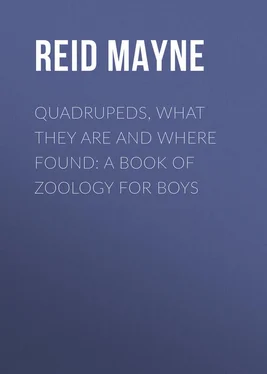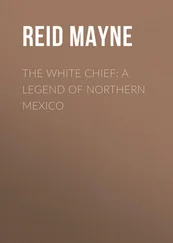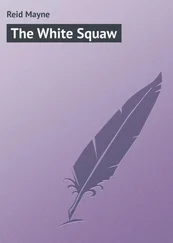Mayne Reid - Quadrupeds, What They Are and Where Found - A Book of Zoology for Boys
Здесь есть возможность читать онлайн «Mayne Reid - Quadrupeds, What They Are and Where Found - A Book of Zoology for Boys» — ознакомительный отрывок электронной книги совершенно бесплатно, а после прочтения отрывка купить полную версию. В некоторых случаях можно слушать аудио, скачать через торрент в формате fb2 и присутствует краткое содержание. Жанр: literature_19, foreign_antique, foreign_prose, на английском языке. Описание произведения, (предисловие) а так же отзывы посетителей доступны на портале библиотеки ЛибКат.
- Название:Quadrupeds, What They Are and Where Found: A Book of Zoology for Boys
- Автор:
- Жанр:
- Год:неизвестен
- ISBN:нет данных
- Рейтинг книги:5 / 5. Голосов: 1
-
Избранное:Добавить в избранное
- Отзывы:
-
Ваша оценка:
- 100
- 1
- 2
- 3
- 4
- 5
Quadrupeds, What They Are and Where Found: A Book of Zoology for Boys: краткое содержание, описание и аннотация
Предлагаем к чтению аннотацию, описание, краткое содержание или предисловие (зависит от того, что написал сам автор книги «Quadrupeds, What They Are and Where Found: A Book of Zoology for Boys»). Если вы не нашли необходимую информацию о книге — напишите в комментариях, мы постараемся отыскать её.
Quadrupeds, What They Are and Where Found: A Book of Zoology for Boys — читать онлайн ознакомительный отрывок
Ниже представлен текст книги, разбитый по страницам. Система сохранения места последней прочитанной страницы, позволяет с удобством читать онлайн бесплатно книгу «Quadrupeds, What They Are and Where Found: A Book of Zoology for Boys», без необходимости каждый раз заново искать на чём Вы остановились. Поставьте закладку, и сможете в любой момент перейти на страницу, на которой закончили чтение.
Интервал:
Закладка:
The San Bernard dog, supposed to be a cross between the mastiff and shepherd’s dog, is too celebrated to require a description here. His sagacity in discovering travellers amid the Alpine snows, and guiding them upon their path, is the quality upon which the fame of this dog has been founded; but it may be remarked that many of the feats attributed to him have their origin in the fertile fancies of Parisian writers.
The Esquimaux dog is another celebrated variety. He is an animal with a fox-like face and thick coat of whitish hair, generally tinged with yellow. He is to the Esquimaux a most valuable companion: trained to draw their sledges over the surface of the snow, and enabling them to make long and rapid journeys – without which these singular people would be ofttimes in danger of perishing amid the inhospitable regions they inhabit.
The Indians of North America possess two or three varieties of domesticated dogs, evidently derived from the wolves of that region. Indeed, the common Indian dogs, found among the Sioux and other northern tribes, bear so close a resemblance to the large American wolf, that they are often taken for this animal, and in consequence shot, or otherwise killed by mistake. The Indians use them for carrying burdens: their tents and tent poles being transported by these animals on long journeys across the prairies. Their flesh is a favourite article of the savage cuisine ; but it is too costly to be used as an every-day food; and is only served up on grand festive occasions. Like the dogs of Tibet, these Indian wolf dogs have the greatest antipathy to a white skin; so much so, that even a friend in that guise can rarely obtain either their confidence or friendship.
A smaller kind than the common one is found among certain tribes, and appears to have derived its origin from the prairie wolf – the jackal of America – while the Hare Indians of the Rocky Mountains possess a third variety; and it is known that still another exists among the tribes of Russian America. This last is short-haired and smooth-coated: therefore differing altogether from the Indian dogs of the prairies.
In Mexico, there are two or three native dogs: found there on the arrival of Europeans. One is the Alco – a dog remarkable for a curious hunch or protuberance upon the back and shoulders, a thick short neck, and small pointed muzzle. He is thinly covered with long hair, of a yellowish colour.
Another singular variety is the dog of Chihuahua and this is, perhaps, the smallest of all canine creatures. Full-grown specimens have been seen, whose dimensions did not exceed those of the common rat; and a singular fact, well authenticated, is, that this dog, when transported from Chihuahua to any other place – even to the city of Mexico itself – invariably becomes larger, or degenerates, as the Mexicans have it! There is also in Mexico a hairless dog. It is, no doubt, the same as that known by the name of Turkish dog; since this variety came originally from Spanish America.
In South America, there are several species of native dogs, found among the savages of the Orinoco and Amazon. They are small animals, usually of a whitish colour: but their owners follow the curious practice of dyeing them with annatto, indigo, and other brilliant dyes, for the purpose of rendering them more ornamental!
We can only find space to say that there are many other varieties of domesticated dogs, almost unknown beyond the countries in which they are found. Such are the Quao of Rhamgur, the Sumatran dog, the Poull of New Ireland, the dogs of Patagonia and Tierra del Fuego – those of the South Sea Islands; and the Waht that inhabits some of the ranges of the Himalayas.
It is reasonable to suppose that there is not a nation upon earth, hardly a tribe – civilised or savage – that does not possess some variety of the canine race differing from all the others.
Chapter Seven.
Wild Dogs
By Wild Dogs , we mean not only several sorts of true dogs, that in different parts of the world are found living in a wild state; but also Wolves, Foxes, Jackals, Hyenas, and Fennecs – for all these are but dogs in a state of nature.
First, we shall speak of the true dogs living in a wild state – that is, apart from the society of man.
It is not necessary here to go into the often-debated question, as to whether dogs were originally wolves, or what species of wolf the dog is descended from. This is all mere speculation, and answers no purpose. It is just as likely that wolves sprang from dogs, as that dogs came from wolves; and every one may perceive that two breeds of the dog species are often far more unlike each other – both in appearance and habits – than a dog is to a wolf itself. Again, foxes differ only from wolves in point of size; and a small wolf is in reality a fox, while a large fox may be equally regarded as a wolf. Furthermore, the jackal is nothing else than another form of the same animal – the wolf or dog, whichever you choose to term it; and the hyenas but a still uglier shape of the same carnivorous creature.
With regard to the true wild dogs – which are not regarded as wolves – we find them existing in various parts of the world. They usually live in communities, and have the habit of hounds – that is, they hunt in packs. Whether they were originally dogs in a domesticated state, and have since seceded from the society of man, is a question which naturalists are unable to agree upon.
In India there are two or three kinds of wild dogs living thus. One in the Deccan – called Kolsun by the Mahratta people – is a reddish-coloured animal, nearly as large as the common European wolf. It dwells in the forests, far remote from the villages – and of course lives by preying upon other animals – just as wolves and foxes do. Again, in the forests of the Himalaya mountains there is another species of wild dog, different from that of the Deccan. It is usually known as the wild dog of Nepaul, from its being found in many parts of that kingdom. A large community of these animals is often met with in the mountain forests – living in caves, or at the bottoms of cliffs, where there are deep crevices among the boulders of loose rocks, that afford them a secure asylum when pursued by their enemies. In these places the dogs sleep, and bring forth their young; and the puppies are taught to be exceedingly wary, and not stray far from their dens during the absence of the mothers. Indeed, so cunning do they become when only a few days old, that it is difficult to capture one of them outside its impenetrable lodging-place.
Конец ознакомительного фрагмента.
Текст предоставлен ООО «ЛитРес».
Прочитайте эту книгу целиком, купив полную легальную версию на ЛитРес.
Безопасно оплатить книгу можно банковской картой Visa, MasterCard, Maestro, со счета мобильного телефона, с платежного терминала, в салоне МТС или Связной, через PayPal, WebMoney, Яндекс.Деньги, QIWI Кошелек, бонусными картами или другим удобным Вам способом.
Интервал:
Закладка:
Похожие книги на «Quadrupeds, What They Are and Where Found: A Book of Zoology for Boys»
Представляем Вашему вниманию похожие книги на «Quadrupeds, What They Are and Where Found: A Book of Zoology for Boys» списком для выбора. Мы отобрали схожую по названию и смыслу литературу в надежде предоставить читателям больше вариантов отыскать новые, интересные, ещё непрочитанные произведения.
Обсуждение, отзывы о книге «Quadrupeds, What They Are and Where Found: A Book of Zoology for Boys» и просто собственные мнения читателей. Оставьте ваши комментарии, напишите, что Вы думаете о произведении, его смысле или главных героях. Укажите что конкретно понравилось, а что нет, и почему Вы так считаете.












